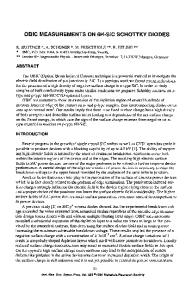Effect of ZnO Nanowire Doping on the Properties of Poly(3-hexylthiophene) Schottky Diodes
- PDF / 102,262 Bytes
- 6 Pages / 612 x 792 pts (letter) Page_size
- 3 Downloads / 353 Views
1212-S11-08
Effect of ZnO Nanowire Doping on the Properties of poly(3-hexylthiophene) Schottky Diodes Rachel S. Aga1 Roberto Aga, Jr.2 and Richard Mu2 1 Department of Chemistry, Wright State University, 3640 Colonel Glenn Hwy, Dayton, OH 45435, U.S.A. 2 Department of Physics, Fisk University, 1000 17th Ave N, Nashville, TN 37208, U.S.A.
ABSTRACT Doping polymers with inorganic nanomaterials to form hybrid nanocomposites is an attractive approach to develop new lightweight optoelectronic materials with unique or improved properties. In this work, poly(3-hexylthiophene) (P3HT) Schottky diodes, doped with ZnO nanowires at different P3HT-to-ZnO concentrations, were studied. Device fabrication was carried out by drop casting the nanocomposite on a Pt electrode followed by thermal evaporation of an Al top electrode. ZnO nanowires were prepared via a physical vapor method with Zn as a source. The nanowires were dispersed in chlorobenzene, then the P3HT powder was added. Properties of the diodes were investigated using capacitance-voltage and current-voltage measurements. In addition, electrical resistance of the nanocomposite films was also investigated using a two-point probe measurement with Pt as Ohmic contacts. Results showed that ZnO nanowire doping decreases the built in potential of the diode and the electrical resistance of the nanocomposite film.
INTRODUCTION Polymer-based materials are very appealing for optoelectronic applications because they are expected to offer simple and low cost processing such as drop casting, spray painting and printing [1]. They are also lightweight and practically scalable. In some device applications, they are blended with other materials to improve performance. For example, polymeric solar cell employing poly(3-hexylthiophene) (P3HT) in the active layer increases the power conversion efficiency tremendously when P3HT is blended with (6,6)-phenyl C61 butyric acid methyl ester (PCBM) [2]. Polymers can also be doped with different nanomaterials to tailor functionality. For example, blue emitting poly[(9,9-dihexyloxyfluoren-2,7-diyl)-alt-co-(2-methoxy-5-{2ethylhexyloxy}phenylen-1,4-diyl)] (PFH-MEH) polymer has been doped with red-emitting CdSe/ZnS core-shell quantum dots and a green emitting metal chelate complex Alq3 to achieve white light emission [3]. The huge surface-to-volume ratio of nanomaterial provides high surface reactivity resulting in the strong interaction with the host polymer. ZnO nanomaterials have been observed to have such strong interaction with a number of polymers leading to intriguing effects. For example, doping poly[2-methoxy,5-(2ethylhexyloxy)-1,4-phenylenevinylene] with ZnO nanocrystals or tetrapods, can increase its hole mobility by two orders of magnitude [4]. It was further suggested that the effect of ZnO was to reduce the density of traps in the polymer. In another report, P3HT was doped with ZnO nanoparticles and employed it as the active layer in a bulk heterojunction solar cell [5]. ZnO
serves as electron acceptor for the P3HT and it facilitates ele
Data Loading...










